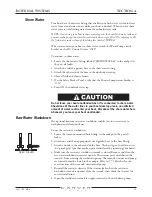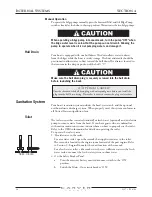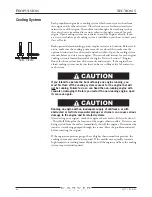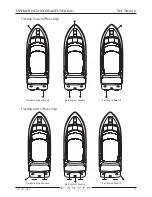
3327 • P2 6/06
63
PROPULSION
SECTION 5
Over time, water can condense inside the fuel tanks, especially in
areas with high humidity. This water can then react with the fuel in the
tanks to create a mixture that can corrode the tanks from the inside.
To avoid this:
• Use the fuel in the fuel tanks as often and as completely as possible.
• Keep the tanks full of fuel when the boat is stored and when it is used
infrequently.
• Do not put alcohol-based fuels in the tanks.
• Check the fuel tanks for water accumulation at least once a year.
Fuel Tank Vents
Each fuel tank is vented overboard. As the fuel tanks are filled during fueling,
air is displaced from inside the tanks and escapes through the vents. Conversely,
when the engines are running, air enters the fuel tanks through the vents to
displace the fuel being used. Refer to Section 9 - Thru-Hull Fittings for the exact
location of the fuel tank vents.
Fuel Shut-Off Valves
Fuel shut-off valves are included with the fuel system:
• Fuel supply shut-off valves are located on the top of the fuel tanks near the aft
inboard corner.
• Fuel transfer line valves (diesel systems only) are located on the bottom of the
fuel tanks near the aft inboard corner.
The fuel supply shut-off valves must be open when operating the engines.
Engine Room Ventilation
Your boat’s engine room is equipped with a ventilation system consisting of
intake ducts, exhaust ducts and bilge blowers. This system is designed to remove
any fuel vapor from the engine room. The bilge blowers operate whenever the
engines are running, as long as the two Bilge Blower circuit breakers on the DC
Control Center are “ON.”
You are responsible for keeping the engine room ventilation system in proper
operating condition. Inspect the intake and exhaust ducts regularly to make sure
they are free of obstructions and have not collapsed or torn. Inspect the blowers
to make sure they are operating properly. Replace any worn components with
new components of the same type.
Operate the blowers for at least 4 minutes and until the engine room is
free of any fuel vapor before starting the engines or the generator.
Summary of Contents for 380 SPORT
Page 1: ...HIN CDR _________________ 380 Sport Owner s Guide 2007 Version 1 ...
Page 2: ......
Page 4: ......
Page 6: ......
Page 8: ......
Page 28: ......
Page 40: ...28 3327 P2 6 06 DC ELECTRICAL SYSTEM SECTION 2 DC SCHEMATIC 3327 324 002 5 12 7 05 ...
Page 54: ...42 3327 P2 6 06 AC ELECTRICAL SYSTEMS SECTION 3 AC SCHEMATIC 3327 300 015 2 9 04 ...
Page 108: ......
Page 122: ......
Page 124: ...112 3327 P2 6 06 WARRANTY AND PARTS SECTION 9 Hatches ...
Page 129: ...3327 P2 6 06 117 WARRANTY AND PARTS SECTION 9 Bill of Material ...
Page 130: ......
Page 131: ...3327 P2 6 06 119 WARRANTY AND PARTS SECTION 9 Carver Limited Warranty ...
















































